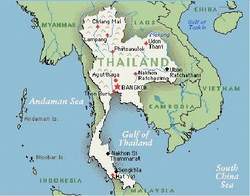Thu, Mar 26, 2015
Country Laying The Foundation For Developing Aerospace Manufacturing
Thailand is laying the foundation for development of an Aerospace Industrial Estate targeting MRO and Tier 2, 3 and 4 aerospace manufacturing segments. This has a potential of bringing $650 million per year by 2023 when the first phase of the park will be operational. The park is planned to be developed in three phases and when all three phases are fully operational, it is forecasted to generate $1.485 billion every year for Thailand, comprised of both manufacturing and MRO services.

Mr. Amartya De, Senior Consultant, Public Sector & Government Practice, Frost & Sullivan says that acting as the project leader for this assignment he is extremely satisfied looking at the response from the global aerospace community in being part of the Thailand Aerospace Hub. He added, "We are witnessing interest from major aerospace maintenance repair & overhaul (MRO) and manufacturing companies from overseas. The foundation blocks of the Aerospace Industrial Estate master plan are being put under the supervision of Office of Transport and Traffic Policy and Planning (OTP) under the Ministry of Transportation. The Ministry of Transportation is all geared up to repeat the same success in aerospace manufacturing and repair industry that Thailand has already achieved in the automotive sector."
The direct revenue impact from the Thailand Aerospace Industrial Estate could garner close to $86.6 billion in a 25 year time frame between 2019-2045. Out of this $32.5 billion has already been planned to be coming out of the pre-built infrastructure such as MRO hangars and component manufacturing factories. The remaining land has been planned to be leased out to aerospace companies depending upon their requirements. The first phase of the aerospace industrial estate is expected to be operational by 2019. The aerospace park construction is expected to start as early as 2016.
"Global tier 2 aerospace manufacturers are constantly facing downward pressure from aerospace primes such as Boeing and Airbus to cut costs in their value chain which is leading tier 2 aerospace companies to make fresh investments in low cost countries that have excellent industrial base, and Thailand precisely fits the bill. Thailand's strong base and efficient labour force in automotive component manufacturing can be effectively leveraged for aerospace manufacturing,"Amartya De said.

However, Mr. De said that aerospace companies are looking for specific business enablers related to ownership, land leasing and related issues that need to be quickly worked out else investors may find alternate destinations in ASEAN for fresh investments.
He added that Thailand's commercial airline MRO spending in 2015 is forecast to be close to $771.0 million which is expected to grow to $1.35 billion every year by 2024. By 2020, a large chunk of MRO spending is forecast to be spent on close to 100 Airbus A320 & 50 Boeing B737 aircraft operating out of Thailand. Part of Thailand's endeavor is going to bringing that MRO spending back to Thailand of course with support from overseas MRO operators setting up their base in Thailand. "We are also looking at the large fleet base of A320 NEO and B737 MAX as regional order books are overwhelming," Mr. De said.
More News
From 2016 (YouTube Edition): The Canadian Forces Snowbirds Can Best Be Described As ‘Elegant’… EAA AirVenture 2016 was a great show and, in no small part, it was>[...]
Airplane Lunged Forward When It Was Stuck From Behind By A Tug That Was Towing An Unoccupied Airliner Analysis: At the conclusion of the air taxi flight, the flight crew were taxii>[...]
Aero Linx: International Stinson Club So you want to buy a Stinson. Well the Stinson is a GREAT value aircraft. The goal of the International Stinson Club is to preserve informatio>[...]
Request Full Route Clearance Used by pilots to request that the entire route of flight be read verbatim in an ATC clearance. Such request should be made to preclude receiving an AT>[...]
"Today's battlefield is adapting rapidly. By teaching our soldiers to understand how drones work and are built, we are giving them the skills to think creatively and apply emerging>[...]
 Classic Aero-TV: Pure Aerial Precision - The Snowbirds at AirVenture 2016
Classic Aero-TV: Pure Aerial Precision - The Snowbirds at AirVenture 2016 NTSB Final Report: Costruzioni Aeronautiche Tecna P2012 Traveller
NTSB Final Report: Costruzioni Aeronautiche Tecna P2012 Traveller ANN's Daily Aero-Linx (11.23.25)
ANN's Daily Aero-Linx (11.23.25) ANN's Daily Aero-Term (11.23.25): Request Full Route Clearance
ANN's Daily Aero-Term (11.23.25): Request Full Route Clearance Aero-News: Quote of the Day (11.23.25)
Aero-News: Quote of the Day (11.23.25)



